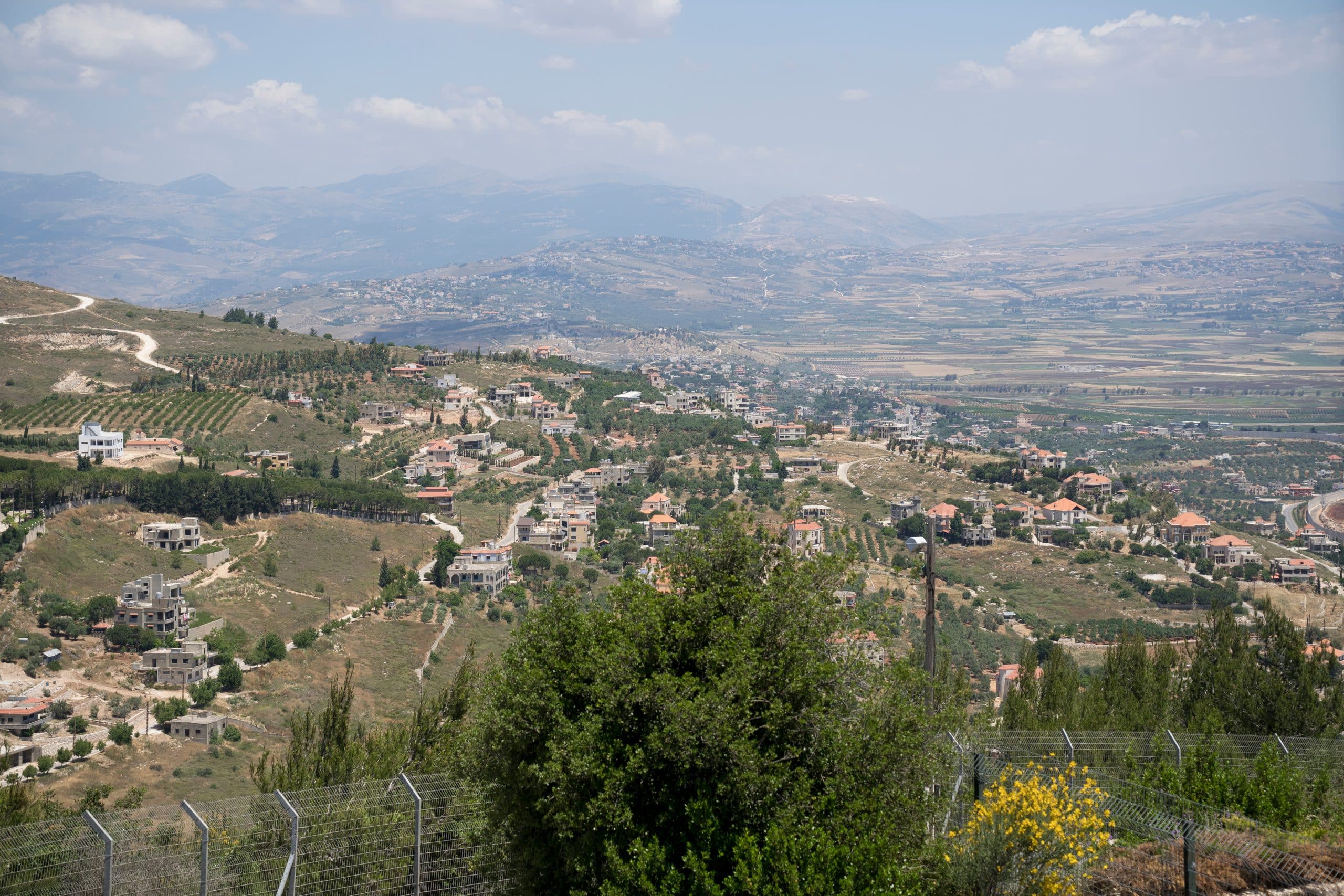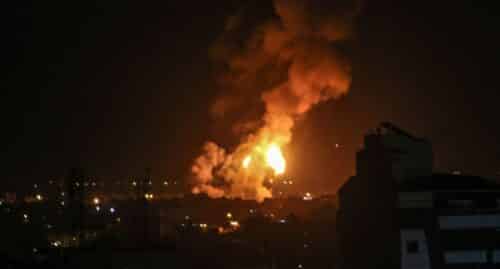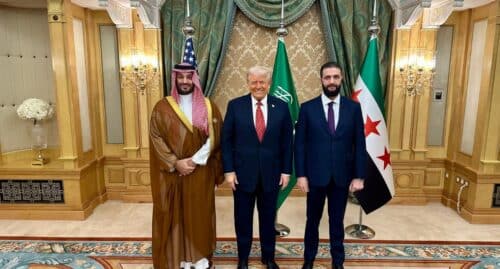
In 2000, the IDF withdrew its forces entirely from Lebanon, ending an 18-year engagement in the security zone. The hasty exit left a vulnerable Lebanese military force in south Lebanon, leading to the disbanding of the south Lebanese army and creating a vacuum into which Hezbollah stepped, having risen to power during the war, making its driving doctrine the elimination of the State of Israel by any means available to it. While this goal was impeded for several years during the Second Lebanon War and the civil war in Syria, where the organization was preoccupied temporarily with assisting the Assad regime fight the rebel forces, the war against Hamas in Gaza was a signal for the terror movement that the conditions had ripened for an active offensive against Israel.
To date, Israel has been refraining from officially declaring war in its northern border. Some hoped for recourse in the form of diplomatic pressure to push Hezbollah away from the border with Israel and out of southern Lebanon, in accordance to UN resolution 1701 issued after the end of the Second Lebanon War. This resolution charged the United Nations Interim Force in Lebanon (UNIFIL) with the task of peacekeeping in south Lebanon. However, despite the resolution, Hezbollah was able to rebuild its force and regained control of the area. Today, the prospects of Hezbollah complying with the resolution and withdraw from south Lebanon are slim, as it had never accepted it to begin with and is currently under no significant pressure to do so. Hezbollah and Iran clearly see the laxness of the international community on this matter, and support from the American administration is lagging as well. Seeing that the majority of the diplomatic pressure on part of the international community is actually aimed at Israel and not on it, Hezbollah sees no deterrence that could force it to hold its fire, or to withdraw.
In the absence of any diplomatic solution that would prevent Hezbollah from establishing its presence on the border and operating there against Israel, and such that can allow the evacuated residents of the northern communities to return to their homes and live their lives safely – the war on the northern arena is not a fanciful notion but a sine qua non. It is nothing short of a moral duty towards the tens of thousands of people who had been living for decades under Hezbollah’s sword of Damocles, and eventually were driven out of their homes and lives by the terror organization’s unrelenting attacks, living for over a year as refugees in their own land and continuing to pay a heavy price for that organization’s bloodthirsty ideology. The time has come for Israel’s war Cabinet to draw the line in the sand and fully advocate a decisive solution on the northern border with the understanding that without an all-out campaign against Hezbollah, the north will never know quiet and the conflict will not see an end – certainly not a victorious one.
South and north: different players, different theaters
The Gaza War is playing out both on Israel’s southern and northern borders. However, while the campaign in Gaza on the southern border is an official offensive action, the campaign on the northern border has yet to be declared an all-out war against Hezbollah, and Israel’s forces have been operating mainly within a mostly defensive position.
The main reason that Israel had refrained from officially declaring war on both fronts out of the gate is related to the size of the IDF’s personnel. Over the years, the army has been downsizing its numbers, creating a situation wherein it cannot undertake a wide scope of operation in both areas at the same time. Thus, it is forced to operate in stages – first completing most of its mission in Gaza, thus allowing it to leave a smaller peacekeeping force in the area, and only then deploying what forces it has to deal with the northern theater, with the intention of making this happen as soon as possible, as with every passing day that Israel is forced to engage with Hamas, it is prevented from taking care of the Hezbollah problem.
In viewing the southern arena against its northern counterpart, it is important to keep in mind that Hamas and Hezbollah are two very different types of enemies. In certain aspects, Hezbollah’s capabilities significantly outweigh those of Hamas, but the Lebanon-based terror organization contends with more than a few Achilles heels.
Operationally, there is no dispute regarding Hezbollah’s superiority over Hamas, with an army of highly trained combat soldiers, huge stockpiles of precision-guided missile, and a vast fleet of attack drones, all supplied by Iran, which is not only the sponsor of the organization but in effect its true handler.
But despite its operational shortcoming in comparison to Hezbollah, Hamas does enjoy a significant advantage that its northern counterpart lacks, and that is overwhelming regional support. Up to the war, Hamas controlled the entirety of the Gaza Strip, militarily and civically. The majority of the residents in Gaza supported Hamas and even mobilized to assist the terror organization. This was made unquestionably apparent with the advent of the war and the daily discoveries by Israeli security forces of tunnel-entrances, military posts, and stockpiles of weapons and ammunitions cached in almost every other house. Contrarily, Hezbollah is ensconced within a hostile arena, surrounded by a host of enemy factions such as the Christians, the Druze and the Suni Muslims. The Lebanese not only do not support Hezbollah, but they point the blaming finger at the terror organization – as well as at its Iranian mentor – for Lebanon’s dire situation which has brought the once vibrant and developed Land of Ceders to the brink of collapse.
Hezbollah’s precarious position in Lebanon means that its war with Israel carries potential critical risks for the organization, as it is well aware that if Israel is able to sufficiently compromise its capabilities, it will affect a shift in Lebanon’s internal politics and enable the rival factions in the country to change the balance of powers such that would prove detrimental to Hezbollah’s position.
The discrepancies between the two theaters and the nature of the enemies naturally sets different objective for each front. While in Gaza the declared goal is the total upending the rule of Hamas’ in Gaza, in the north Israel has no designs of toppling Hezbollah, as it knows that when all else fails, Hezbollah could always resort to withdrawing solely to Beirut or even to Syria. And anyhow the organization is a proxy of the Iranian Ayatullah regime, which supports and assists it and views it as a more important player than Hamas, thus the total eradication of Hezbollah is highly unlikely within one limited campaign.
Therefore, Israel’s objectives in the northern war theater are to push Hezbollah northward to upper Lebanon, destroy its infrastructure on the border with Israel and debilitate its leadership and ultimately create the conditions for the residents of the north to return safely to their homes.
These are three crucial objectives. All three are within Israel’s reach.
Beyond the red line; time for declaring the objective of the war in the north
The State of Israel has of yet to officially declare war up north. This despite the fact that the IDF has been operating in that sector since October 7. In the time that has passed, the IDF had targeted Hezbollah’s areal defense systems thereby restoring Israel’s freedom of operation in Lebanon’s aerial space. At the same time, it had also taken out a considerable portion of the command of Hezbollah’s special ops unit in south Lebanon, Radwan Force, and had destroyed many of the organization’s infrastructures and had pushed part of Hezbollah’s forces several kilometers northward into Lebanon.
All the above have created probably what would be the best conditions Israel can hope for to launch a broad offensive against Hezbollah. Yet there are many voices calling for the suspension of such a move due to considerations of personnel and ammunition shortages and battle fatigue of the forces, among others. However, anyone calling for suspension lacks a clear understanding of the reality on the ground and the severe consequences such a decision could have.
The first issue with this approach is the indefinite delay in the safe return of families to their homes, which aside from the humanitarian issue also constitutes a consequential ideological crisis that could truly jeopardize the Zionist enterprise. The longer the residents of the north remain in their substitute homes, chances of their full return home to live yet again under threat grow slimmer, thus the vital continuity of settlement along a border with a major security importance unravels, and decades of achievements gained by the Zionist enterprise of settling the entire historic land of Israel are rolled back, not to mention the gaping loss of productivity that the region contributes to Israel’s GDP – these are but a few of the prices a delay in a resolution on the norther border will exact on Israel.
The second outcome of such a delay is akin to gifting one of Israel’s largest enemies with the time it direly needs to lick its wounds, regroup and regain its malicious power. If Iran and Hezbollah know that Israel will declare an all-out war only in a year, or possibly two, the immediate action they would undertake is to pour their entire network of militias in the Middle East into south Lebanon, reequipping and retraining them, now with a better understanding and more experience in Israel’s military tactics and strategies, and use them against us, having had the time to prepare for Israel’s new order of battle.
It is also worth mentioning that beyond the above considerations, there is the toll that a war with Hezbollah will exact on the Israeli population. A crucial element in an army’s resilience is a strong civilian backbone, and a war against such an able enemy is sure to subject the civilian population of Israel to challenges such as advanced missile attacks wreaking destruction on vital infrastructures (roads, water, electricity) possibly even claiming lives, rising costs of living, and the disruption of daily life. These burdens are easier for civilians to bear when moral is high and they can get behind the leadership and army and support the cause. Israel has been at war for over a year, with the civilian population’s support and willingness to contribute whatever it takes to win and restore quiet and security. However, in a year or two, a new war might prove to be a very difficult sell to the jaded Israeli public.
A crucial element in an army’s resilience is a strong civilian backbone
Short and forceful: possible scenarios for a war in the north
Many in Israel fear a third Lebanon War that would drag on for years, as the collective memory still holds the pain of the first and second Lebanon wars that claimed a precipitous cost in lives and left the country in deep trauma that is still felt to this day. However, with lessons well-learnt and with the right command, a war in Lebanon now could be even shorter than the campaign in Gaza. The goal is to land a swift, decisive blow on Hezbollah, twisting the organization and Iran’s arm into seeking a mechanism that would provide them with a quick exit. Iran fears the loss of its most nurtured proxy, and a debilitating blow on part of Israel to Hezbollah could very likely leave Iran scurrying to end the war. Moreover, it can put into play another lever against Iran in the form of internal Lebanese forces that are hostile to Hezbollah and would be more than happy to get the organization’s back up against a wall.
But this might prove easier said than done, what with pro-Iranian support players the likes of Syrian militias, which would likely come to Hezbollah’s help, complicating things for Israel. A suitable preemptory action would be Israel informing the Syrian regime, that if it chooses to join the fray, a swift and decisive retaliation will follow.
Iran’s active involvement in such a war could actually play out to the advantage of Israel, as it would be a green light for America to join in, possibly putting in motion what might very well become a global war, with strong western militaries – and odds – stacked up against Iran. The Shi’ite Republic would be advised to weigh its steps carefully in such a scenario.
One way or another, Israel will have to ensure that south Lebanon remains a sterile, unpopulated area without any presence whatsoever of Hezbollah. Israel has no designs of annexing nor settling in south Lebanon, surely. Nonetheless, Israel must control the area at least for an initial interim period, meaning that all the Israeli forces positioned on the Lebanese border on the Israeli side will have to be moved into Lebanon. Similarly to the IDF’s military buffer zone in Gaza, Israel will have to deploy its forces in the south Lebanon area, using the Litany River as a natural border. The short-term objective is to have the returned residents of northern Israel see the IDF when the look towards Lebanon, and not Hezbollah.
Alongside the deployment of forces, Israel must generate international pressure that would lead to the disbanding of Hezbollah, as the state of affairs in which a neighboring country is controlled by a terror organization hell-bent on the annihilation of Israel can no longer be acceptable. The international community must be harnessed to devise a long-term and sustainable solution, as Israel can no longer trust what until now was an ineffective UN peacekeeping force to ensure the quiet on its border, and expects a solution that includes the placement of a substantial international military force that could deal with Hezbollah if necessary.
The initiative must be in Israel’s hands: conditions for ending operations in Lebanon
As explained above, there are three conditions for ending Israel’s operations in south Lebanon – the scouring of that area of Hezbollah’s presence, the crippling of the organization and its infrastructures, and the securing of conditions for the northern residents to return safely to their homes. All of these are obtainable objectives, even perhaps in the near future. It requires creative thought and determination, and Israel must take the initiative to make this happen.
Finally, in response to the claims that Israel’s soldiers are already suffering from battle fatigue at this point of the war – it is important to remember the other side of that coin: the soldiers and commanders that will go to the northern front have immense battle experience and understand crucial lessons learnt in the past year. So rather than a fatigued army, the IDF is now a well-oiled and unstoppable fighting machine, so let us not stop it from doing its job.





